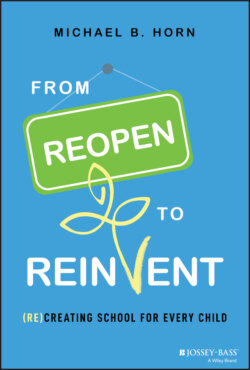Читать книгу From Reopen to Reinvent - Michael B. Horn - Страница 28
WHAT THIS COULD LOOK LIKE IN K–12 SCHOOLS
ОглавлениеWhen talking to K–12 education leaders, this framework can feel overwhelming and even impossible. How could administrators possibly grant the required autonomy short of forming a wholly new school? That's what the Hawken School, a prestigious private school near Cleveland, did, for example, to pioneer mastery-based learning. It created a school called the Mastery School of Hawken. And it's what another prestigious private school, Lakeside School in Seattle, did to launch a new microschool, the Downtown School, at a significantly lower price point.
Is this strategy out of reach then for public schools?
No.
In K–12 schools, an autonomous team could take many forms. A superintendent could free a group of educators in a district from their day-to-day roles and task them with reimagining what they might offer. This group might function as a separate team within a school and pioneer either a new classroom model or a novel way of offering a particular subject or grade. The independent group could also exist as a school within a school, a microschool, or a learning pod. It could also create a new school entirely.
The charge might be to design a more compelling experience that focuses less on the time students are taught and more on helping each child develop character and habits of success, like agency and executive function skills; ensuring each child has a strong social, emotional, and health foundation with a reservoir of social capital; and rather than simply focusing on the teaching of academic knowledge and skills, making sure each child learns and masters those that are critical and allows them to build passions and develop their unique potential. The traditional hierarchy in a district could continue to focus on operating schools as we've known them, while this group focuses on implementing different innovations designed to give teachers and students more support.
This model suggests a new way for districts to engage with microschools and learning pods. Many districts have viewed these emergent schools as threats to the way they have always operated or things that will create inequity. But the threat–opportunity perspective helps us see that districts could reframe microschools and learning pods as something they themselves could operate to make sure that all children have deep and healthy social relationships. They could envision them as part of a mosaic of offerings so that they are able to provide an array of options that fit the different circumstances of all students and families. And they could see them as ways to offer personalized learning experiences for children's particular needs so that children don't fall behind in learning to read or doing math or in the exploration of coherent bodies of knowledge.
The key is to escape threat rigidity by arming a relatively independent team of educators absolved from their existing responsibilities. However it's done, the autonomy and focus is critical.
As Jeff Wetzler, cofounder of Transcend Education, a school design consultancy, said, “[The work is] time consuming. We have yet to find a way for this to work without some protected time and space. If you just try to jam it into the existing schedule, it just doesn't happen.”
Or as Tavenner said, “School doesn't stop. Usually educators think ‘I get one week to do my master visioning’ in the summer and that's it.”14 That's not enough time to rethink the possibilities for an already-antiquated schooling model and view it as a true greenfield opportunity.
We dig deeper throughout the book on how to rethink schooling, but there's one final observation in Gilbert's findings worth highlighting.
In his research, an outside party wielded significant influence with each of the newspapers that moved successfully from seeing the Internet as a threat to viewing it as an opportunity and tasking an independent group to chase it. A board member, associate, or someone new to the organization would say that the newspaper must question its fundamental assumptions around what their online site and the supporting structure should look like rather than simply replicating what they already had—just online. As Gilbert wrote, “Involving outside influence when deciding how to respond to discontinuous change will increase the likelihood that managers will structurally differentiate a new venture from its parent organization.”15
In schools, that implies that school boards and the broader community have a critical role to play in giving permission to or pushing school and district leadership to create relatively independent entities that pioneer new ways of schooling—whether those arrangements are new schools, schools within schools, microschools, or learning pods. As Gilbert wrote, “Outside influence, structural differentiation, and opportunity framing [that] combine to relax routine rigidity in a new venture” were consistently critical in times of discontinuous change.16 Examples from real districts help show what that arrangement and sequencing can look like.
Mastery School of Hawken:
https://www.youtube.com/watch?v=LZ2Pk6TcQCU
